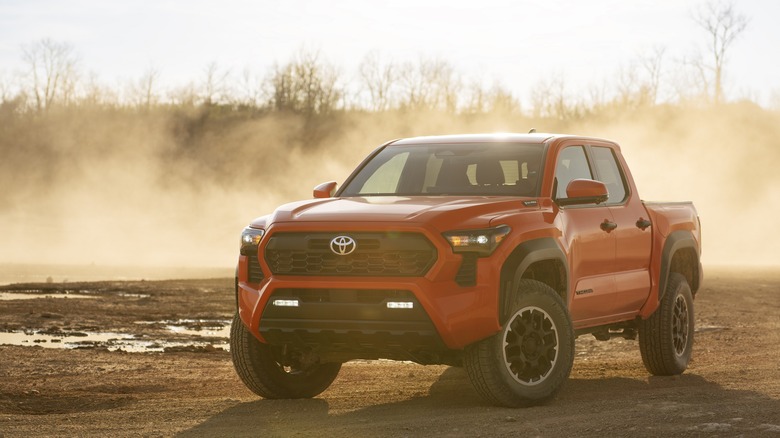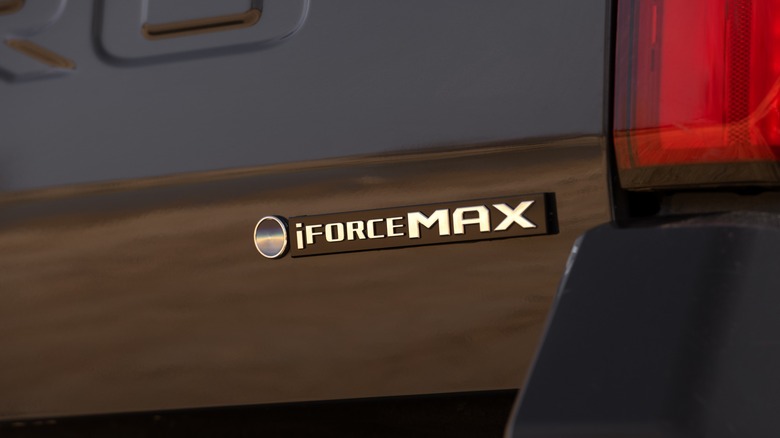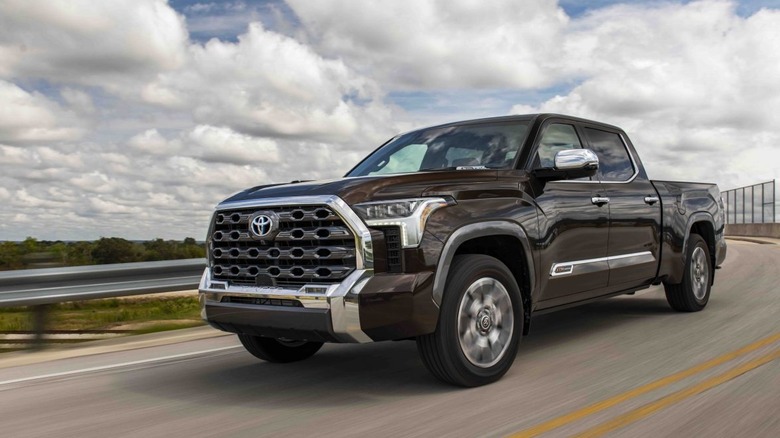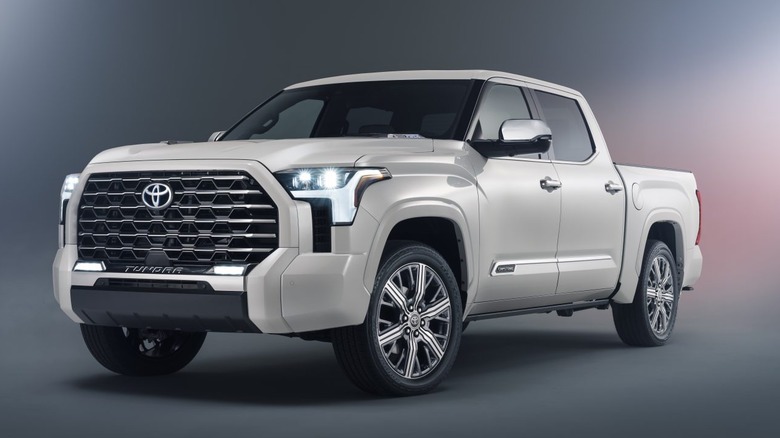The Biggest Differences Between Toyota's Tacoma & Tundra I-Force Max Models
Toyota trucks are pretty iconic. The Tacoma is one of the most popular midsize trucks in America and the Tundra, while it's not the sales juggernaut in the full-size class that the F-150 and Silverado are, is still an impressive pickup. The Tacoma is well-known for its off-roading prowess and the Tundra is hefty enough to haul over 11,000 pounds – both trucks have strengths worth noting and now, they both share the distinction of offering hybrid powertrains.
The Tacoma and the Tundra both offer what Toyota calls i-Force Max powertrains, also known as hybrids. They are a bit unique — the Tacoma uses a four-cylinder and the Tundra uses a V6 — but they offer similar benefits. Both boost fuel economy and horsepower, and they provide massive increases to torque, an excellent virtue on any vehicle but especially useful when it comes to pickup trucks. But what's unique about each of these models? How much can each truck tow and haul? And just how much added fuel economy and horsepower does the i-Force Max system provide?
What's powering the Tacoma?
The Toyota Tacoma used to be available with a V6, but no more. Instead, the all-new 2024 Tacoma gets a choice of two different four-cylinder powertrains. The first is a turbocharged 2.4-liter engine (called the i-Force) that's paired with your choice of a six-speed manual transmission or an eight-speed automatic. With the manual, the Tacoma puts out 270 horsepower and 310 lb-ft of torque. Go with the automatic and there are two power ratings: 228 hp and 243 lb-ft on the base SR model, 278 hp and 317 lb-ft on other trims. The base powertrain that provides those numbers is called simply the i-Force. It's adequate, but only scratching the surface of what the Tacoma can provide.
The optional i-Force Max powertrain uses the same 2.4-liter engine, but it adds a 48-hp electric motor integrated into the same eight-speed transmission and paired with a 1.87-kWh battery. Combine the two, and you get some pretty big numbers: 326 hp and 465 lb-ft of torque. That's an increase of nearly 50 percent more torque over the standard model and nearly double the torque from the old V6 Tacoma (265 lb-ft). Unfortunately, the maximum towing numbers are down with the new Tacoma, topping out at 6,400 – 6,500 pounds compared to the old V6's max of 6,800 pounds. That's a drop off, sure, but it's relatively small and the payoff of improved fuel economy (more on that in later sections) will be worth it to new owners.
What's under the hood of the Tundra?
Like the Tacoma, the Tundra has a choice of powertrains. The first available engine is a turbocharged 3.5-liter V6, also called the i-Force. It produces 389 horsepower and 479 lb-ft of torque, and is mated to a 10-speed automatic transmission. The i-Force Max powertrain for the Tundra builds on that V6's architecture by sandwiching a 48-horsepower electric motor in the middle – similar to the setup in the Tacoma. The Tundra also uses a 1.87-kWh battery with its hybrid system. Placed between the engine and the transmission, the electric motor and battery increase the Tundra's overall output to 437 horsepower and 583 lb-ft of torque. The previous-generation V8-powered Tundra? That made just 381 horsepower and 401 lb-ft of torque. That's less than the standard V6 on the newest model but way less than the i-Force Max.
The towing differences are big too. The previous-generation Tundra, last sold as a 2021 model, could tow a maximum of 10,200 pounds. That's no small number, but it's significantly less than the current i-Force Max model that tops out at 11,450 pounds. The payload is up too. The previous-generation Tundra topped out at a maximum payload of 1,730 pounds, depending on the trim level. For comparison, the newest Tundra has a max payload rating of 1,940 lbs. Some Tundra owners might miss the V8, but it's clear that the new hybrid wins when it comes to sheer capability.
What's the difference between these two trucks?
To put it simply: the Tacoma is smaller than the Tundra and that's reflected in its capabilities and its price. The two i-Force Max systems work similarly, making the two Toyota's surprisingly fuel efficient and giving big torque increases over the standard models. The Tacoma can't tow or haul as much as the Tundra, but since it's significantly smaller it might be a better fit for owners who drive in the city a lot. The Tacoma's appeal increases a bit more, however, when you compare the fuel economy and pricing of the two trucks.
Fuel economy estimates from the EPA put the Tacoma as high as 21 mpg city/26 mpg highway and 23 mpg combined. Most Tacoma trim levels hover around 21 mpg combined. The Tundra, however, tops out at 20 mpg city/24 mpg highway and 22 mpg combined, with most trim levels sitting around 20 mpg combined. And, as you'd probably expect from a full-size truck, the Tundra is more expensive. The least-expensive versions of the Tacoma check in at $31,500 (plus destination) and top out at $63,900 (plus destination). The Tundra? Its least-expensive trim level is $45,500 (plus destination). At the top of the range, its price tag is an eye-watering $76,565 (plus destination).



